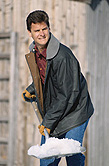
SATURDAY, Jan. 22 (HealthDay News) — Snow shoveling is a dangerous chore that causes an average of nearly 100 deaths and 11,500 emergency department visits each year in the United States, according to a new study.
And while most of the problems occur among adults, kids under 19 experience more than 1,750 shoveling-related injuries each year, the investigators found.
The analysis of data from 1990 to 2006 found that the most common shoveling-related injuries were soft tissue damage (55 percent), cuts (16 percent) and broken bones (7 percent).
The most frequently injured areas of the body were the lower back (34 percent), the arms and hands (16 percent) and the head (15 percent), the study authors noted. Common causes of injuries were acute musculoskeletal exertion (54 percent), slips or falls (20 percent) and being struck by a snow shovel (15 percent).
Heart problems accounted for only 7 percent of all shoveling-related cases but were responsible for more than half of the hospitalizations and all of the 1,647 deaths during the 17-year study period, according to the report published in the January issue of the American Journal of Emergency Medicine.
People 55 and older were more than four times more likely than younger people to experience heart problems while shoveling snow. Among those over 55, men were twice as likely as women to suffer heart problems, said the researchers at the Center for Injury Research and Policy of The Research Institute at Nationwide Children’s Hospital in Columbus, Ohio.
“The cardiovascular demands of snow shoveling are increased by the freezing temperatures that typically accompany snowfall,” study senior author Dr. Gary Smith, director of the Center for Injury Research and Policy, said in a hospital news release.
“Not only is the heart’s workload increased due to shoveling snow, but cold temperatures also add to the chances of a heart attack in at-risk individuals. We recommend talking to your doctor before you shovel snow, especially if you do not exercise regularly, have a medical condition or are in a high-risk group,” Smith added.
Alternatives to shoveling include using a snow blower, hiring someone else to do it, or using salts, de-icing sprays or heated sidewalk mats.
And before sending the kids out to clear the snow, explain to them that shovels are tools and are not meant for horseplay. Shoveling injuries suffered by children and teens often result from being struck by a snow shovel, with two-thirds of those being head injuries, the doctor pointed out.
“Shoveling snow can be a great outdoor activity for kids; however, it is important for parents to teach children the correct way to shovel snow and remind them that shovels are not toys,” said Smith, who is also a professor of pediatrics at the Ohio State University College of Medicine.
More information
The American Physical Therapy Association offers snow shoveling safety tips.

